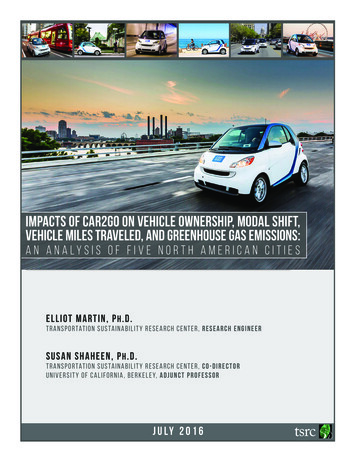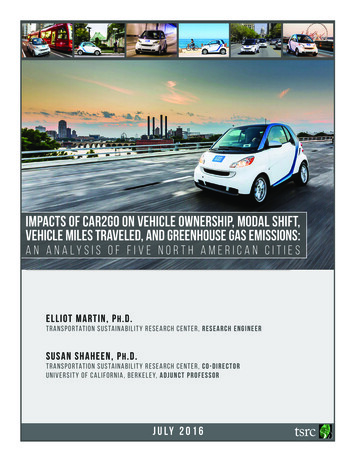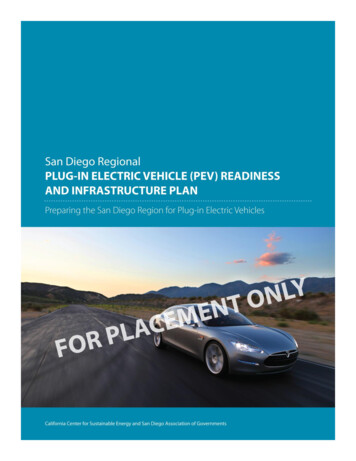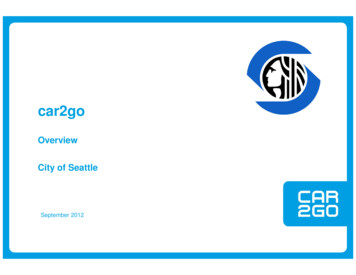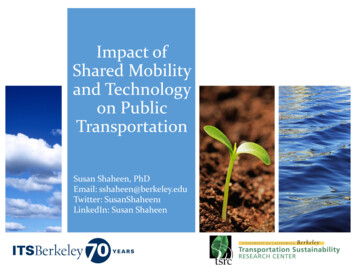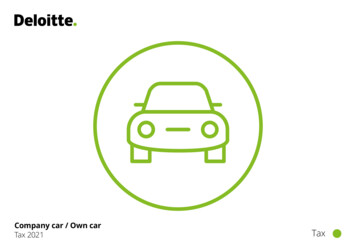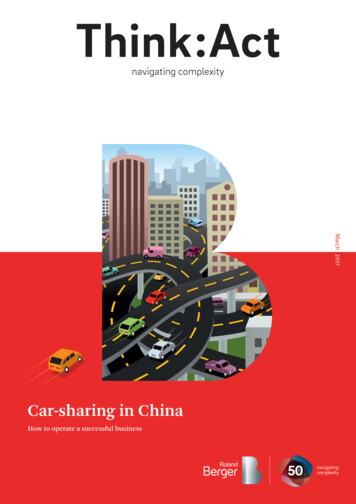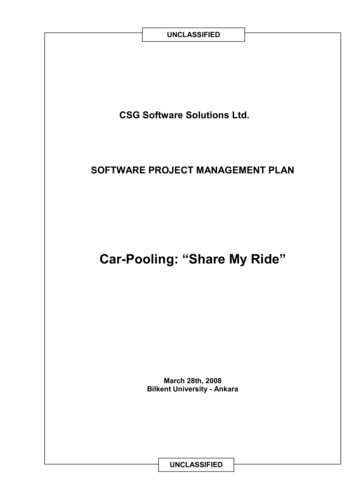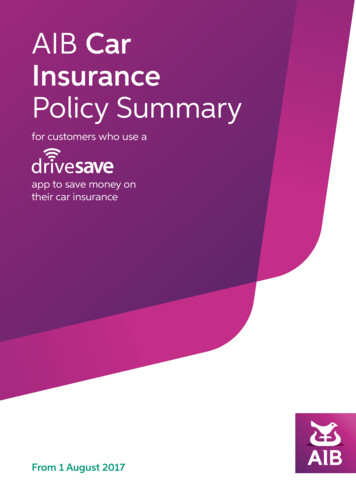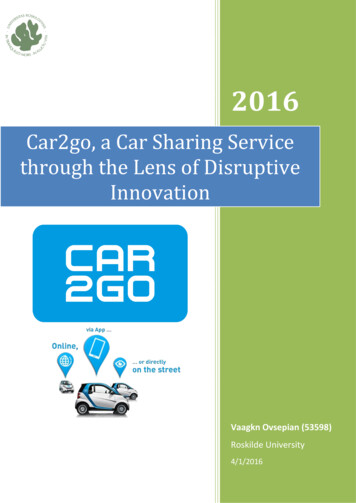
Transcription
2016Car2go, a Car Sharing Servicethrough the Lens of DisruptiveInnovationVaagkn Ovsepian (53598)Roskilde University4/1/2016
Table of ContentsIntroduction .4Case Description .6Problem Formulation.7Research Question .9Theoretical Framework (Literature Review) .9Review of Relevant Extant Literature . 9Service Innovation. 9Disruptive Technology . 10Disruptive innovation . 10Sharing Economy . 11Review of External Business Analysis Models Used In the Study . 12PEST. 12SWOT. 13Porter‟s five forces . 13Market trends. 14Studies on the topic . 14Methodology .19The Research Tools and Their Creation . 20Component Elements of Conceptual Tools and the Object of Study . 20Probing tools . 21Comparative and evaluative tool . 21Broad Methodology of Creation of the Tools . 21Conceptual Torch Creation . 21Based On Problem Formulation . 21Based On Case Description . 22Conceptual Lens Creation . 23Layer 1: Based on Literature Review . 23Layer 2: Based on Disruptive Innovation Theory . 24Layer 3: Based on Market Analysis Tools . 25Questionnaire and assumption structure creation . 25Analysis .26Final Points of the Conceptual Torch Based On Broad Methodology . 26Final Structure of the Conceptual Lens Layer 1 (Based on Review of Literature) . 27Final Structure of the Conceptual Lens Layer 2 (Based On Disruptive Innovation Theory) . 27Market Analysis - Conceptual lens Layer 3 (Probing Tool for the study) . 28SWOT. 282
PEST. 30Porter‟s Five Forces Analysis. 33Research Assumptions based on the Research Questionnaire as Evaluative tool . 34Discussion .35The Comparative Evaluation . 35Conclusion and Future Perspectives.37References .393
IntroductionThe industries and businesses around the world have now been witnessing unprecedentedchanges with growth in the last two decades at a rate that seems much faster than the whole ofthe last century. The prime reason that is apparently behind such a fast rate of changes is theinnovation rate in general and services innovation in particular. The present study, based on apreliminary review of literature as part of its endeavour to achieve a better framework forunderstanding and applying the theory and principles of innovation in general and what hascome to be known as disruptive innovation in particular strives to understand the serviceinnovations and put them in proper context towards the objectives of the study. (Cortez, 2014)The study further goes on to understand and present the concept of disruptive innovationas put forth by Clayton M. Christensen and further studied and enriched by other scholars andresearchers. Disruptive innovation being based on the concepts of service innovation anddisruptive technologies has been presented and studied as a focal concept for this study. Theliterature review has defined and contextualized the concept and theory of Disruptiveinnovation with its essential elements capable of bringing about disruptive changes to themarket settings as well customer preferences through initially low end technologies frommainstream business perspective (Shaheen & Cohen, 2012). The same is discussed in thereview of literature section. Based on the review itself, the work discusses the contextual roleof Business model as well as car sharing services as a prime example of disruptive innovationand attempts to create a conceptual lens by means of analytical management tools such asPorter‟s five forces, SWOT and PEST of the Car2go services as a case study for disruptiveinnovation.Business model innovation has been understood as an important allied concept ofdisruptive innovation in the sense that disruptive innovation as a concept and theory which isbased essentially on disruptive technologies can achieve predictive value only once thecompatible business model innovation is figured out and practiced.Car sharing services have in the last few years developed into a fully fledged industry andform an important component of the booming sharing economy. Based on their disruptivebusiness models and eco friendly technologies, these beacons of the sharing economy havebecome the preferred areas of interest and investment for various economies around theworld. Car sharing is being increasingly seen as a flexible transportation alternative whichalso reduces the negative social, economic and environmental impacts of private ownership ofcars and vehicles. Car sharing industry which originated in Europe a few decades ago has now4
present in all the continents is based on the advances in disruptive technologies is growing atan unprecedented rate in the last few years and disrupting the incumbent industries in itssector (Yu & Hang, 2009).Car2go is seen one of the brightest spots in the car sharing industry particularly on thedisruptive innovation horizon. With its free floating, electric car fleets, it has managed to beatthe factors restricting the growth of car sharing for a long time. The Car2go services havebeen systematically introduced and innovated for bringing the best results and in the processhas seemingly disrupted many traditional business models and frameworks in the automobileand allied industries (Yu & Hang, 2009). It has also changed the way the consumer or clientsperceive and make their transportation choices. However, a critical evaluation of whetherCar2go fits the description of a perfect disruptive innovation as a case needs to be ascertained,which is the prime objective of this study.5
Case DescriptionThe present study strives to ascertain whether Car2go, the Car sharing service by theautomobile manufacturing company Daimler, qualifies as a good case example for disruptiveinnovation. As the review of literature suggests, Car2go was launched in 2009 in the city ofUlm, Germany. By the end of 2014 Car2go fleets of 250 - 1200 vehicles 26 cities acrossNorth America and Europe were being offered (Finkorn & Muller, 2014). In 2011, Car2golaunched a fleet of all electric cars in San Diego California USA. This was preceded bylaunches in various North American and European cities (Shaheen & Cohen, 2012). In 2011itself, Car2go announced expansion to 50 cities in Europe and a few locations in NorthAmerica. Car2go later launched a social media based pilot project. It is thus apparent thatCar2go right from its birth has been experimenting and systematically evolving over a periodof time and has seen unprecedented growth. It has expanded internationally in very short spanof time and has affected the automobile industry and set benchmarks for others to follow.Evidently, Car2go is a project that was conceived and implemented as an innovativeinitiative. Daimler, initiated the project to take advantage of the huge crowd sourcing andshared economy trends emerging at the time, with enabling IT infrastructure that hadsufficiently evolved by the time, Car2go was launched. The fact that Car2go wassystematically launched in various cities around the world in its various versions such asdiesel and electric also show that innovation was at the core of Car2go as a project. As anyinnovative project the purpose of systematic launches was to gain sufficient iterativeknowledge of best business practices suitable for continued growth and evolution of the carsharing space in the automobile industry. As suggested by a preliminary review of literatureas part of this study, Car2go is continuously experimenting not only with car technology, butalso user and operational technology such as user interfaces. The best part of Car2go‟sevolution has been the positive environmental effects it has had. The effects have been studiedby various scholars over a period of time now and lessons for other industries are being drawnfrom the same.Quite literally, Car2go is forcing the businesses, regulators as well as customers tochange their preferences and choices regarding car sharing. Also suggested by peek in to therelevant literature, the way the businesses are adopting and adapting to Car2go‟s initiatives interms of technology and operations, shows the disruptive power of Car2go‟s business model.The disruptions have extended well into the regulatory as well as the customer decision6
realms and have affected the car regulatory bodies to take notice and adapt to the changesbeing brought about due to innovations in car sharing space, led by a few players of whomCar2go is a major one. One of the most intriguing aspects of Car2go‟s innovation has beenthe development of capability to provide free floating car sharing systems. The same are beingreplicated internationally. Car2go‟s innovations have reduced and posses a still greaterpotential to reduce private car ownerships (Finkorn & Muller, 2014). On the regulatory front,Car2go evolving as the largest free floating car sharing service in the world (Vine, Zolfaghari,& Polak, 2014), it has and continues to present unanticipated benefits and risks. This has apotential to disturb the balance between regulators, industry and consumers (Cortez, 2014).Car2go has led the way in car sharing services restructuring the costs of car based mobility.The higher fixed costs of car based mobility are averaged out by the car sharing services suchas Car2go. The regulators have to restructure their taxation structure for example to adapt tothese changes in cost structure.Car2go presents the researchers, based on the review of its performance in the innovativespace, with a need to determine whether the innovation of Car2go indeed follows thetheoretical path suggested by the disruptive innovation theory.Problem FormulationThe preliminary literature review as well as the case details above, prompt us to examineas to how Car2go seems like a disruptive innovation. The need presents us with a problemwherein Car2go has to be evaluated from a theoretical perspective to set a perfect example toguide the businesses towards successful disruptive innovation. The problem thus presentedthough is multidimensional and has to be deconstructed to simplify and solve.Car2go is suggested to be a case of disruptive innovation by a preliminary research. Thepreliminary research as recorded in the review of literature section suggests that Car2go hasbeen in a state of constant innovative change since its birth and in fact its birth itself wasbased on utilizing unique business opportunity presented at the time, enabled by technologicaland business advances. The overarching features being systematic innovation, disruptive userinterface and constant experimentation with the car technology and business processes on thecausal side and reduction of private car ownership and its consequent effects on the effectualside, Car2go presents itself as contender for further examination towards the disruptiveinnovation fit.7
Disruptive innovation as a theory is itself limited in its predictive value. Also, as per theinitial review of literature, the usefulness of disruptive innovation theory as a predictiveframework is seriously limited by overt emphasis on attack and consequent floundering of theincumbent firms and industries. However, for disruptive innovation theory to be of real valueit has to take into account the value for both disrupting as well as incumbent firms as arelative effect, based on fulfillment of individual conditions based on the learning value of thetheory for the given set of firms or industries. Car2go has to be examined in the light of thislimitation and the additional conditions for it to provide disruptive learning value need to bedetermined.The technologies used by Car2go have to be determined to be disruptive in naturethrough further research. The technologies play a pivotal role in qualifying a business asdisruptive or not and it is the technologies which initially appear to be trivial in nature that areresponsible for building a gradual sustainable advantage around itself which eventually pose athreat to the mainstream technologies.Car2go business model has a need to be likened to a disruptive business model as wellsince it is the business model which in effect harnesses a the disruptive technology to anadvantageous position for the disrupting as well as presents learning opportunities for thedisrupted and incumbent firms.Car2go in spite of the apparent disruptive effects has not yet been critically analyzed onconceptual premises of the disruptive innovation theory. The research so far though has putCar2go on a high disruptive innovation pedestal has so far lacked in a critical assessment onthe disruptive scale both quantitatively as well as qualitatively.8
Research QuestionThe above discussion towards problem formulation thus brings us to the chief researchquestion as mentioned below.The present study seeks to determine whether the services provided by Car2go can beseen as disruptive Innovation. The research question is further deconstructed and analyzed forstudy in the Methodology section below.Theoretical Framework (Literature Review)Review of Relevant Extant LiteratureService InnovationAs per Financial Times (Service Innovation, 2015) Service innovation is the one – “thattakes place in different forms using different factors such as IT, hardware, knowledge andinvestment in staff training, marketing and research and development (R&D).” Serviceinnovations themselves can easily be copied and cannot be safeguarded for long. Although theadvantage accruing out of service innovations coupled with right timing and unique businessmodels to capture the unique value of the innovation early on can help safeguard theadvantage.Another study (Hertog, 2010) has conceptually defined service innovation based on afour dimensional model. The four defining dimensions of service innovation are serviceconcept, the client interface, the service delivery system or organization and the technologicaloptions available. Further, the study identifies the importance of organizational or nontechnological innovations in services. The service innovation is rarely One-dimensional and isbased on a combination of two or more dimensions mentioned above. The dimensions ofservice innovation are usually replicated in other industries or sectors. The combinations ofthe service dimensions may change in role of a given dimension in the overall innovation withtime. Service innovation strategies vary with overall business strategies of firms. Serviceinnovation is usually the result of proliferation of specialized service functions. The serviceinnovations cannot be restricted to the given firm and spreads across the industry. Regulationor de regulation can cause innovations to occur in service industries.9
Disruptive TechnologyDisruptive Technology (Christensen, 1997) refers to “a new technology having lowercost and performance measured by the traditional criteria, but having high ancillaryperformance.” The low end and seemingly trivial technologies attack the establishedtechnologies and eventually capture the customer value over a period of time (King &Baatartogatokh, 2015).Scholar (Chesbrough, 2010) has studied the notions and concepts of „disruptivetechnology‟ and „disruptive innovation‟ within the purview of Business Model Innovation. Hehas observed that companies can commercialize new ideas and technologies through theirbusiness models. Further they emphasize that same idea or technology taken through twodifferent business models will yield two different business outcomes. He thus stresses theimportance of business model innovation. He further explores the barriers to business modelinnovation and the cognitive competencies which are required to identify these barriers andalso ways to overcome them.Authors (Utterback & Acee, 2003) have identified and discussed the limitations of theabove conception of disruptive technology. They have pointed out that C. Christensen in hisbid to give undue importance to the “attack from below” has ignored various other changepatterns that may best be described as discontinuous in nature. They have emphasized thateven in C. Christensen‟s view the importance of disruptive technology lies not displacementof established products but enlarging and improving the scope of markets and adding to theirfunctionalities. Further, the authors present an alternative scenario wherein a high endinnovation is introduced into a demanding market and later moves towards the mass market.Disruptive innovationDisruptive innovation (Yu & Hang, 2009) as per the disruptive innovation theoryadvanced by C. Christensen defines disruptive innovation in terms of technologies thatemerge as a result of a process. The process, which produces technologies that provide valuethat is different from the mainstream technologies of the time and are initially inferior interms of mainstream customer value are called disruptive innovation. Disruptive innovationhas been graphically represented and defined in terms of the trajectories of changingperformance of the firm and/or the industry with time along with the level of performancedemanded by the customers (Figure 1). The points on the graph where the two trajectoriesintersect can be identified as points of disruptive innovation. Further innovations have beenidentified as sustaining versus disruptive as attributed to C. Christensen.10
Figure 1: Disruptive Innovation Model (Christensen & Raynor, 2003)In this context, it is important to point out the evaluations of predictive value of thetheory of disruptive innovation. A study (King & Baatartogatokh, 2015) identifies the fourkey elements of the theory to further evaluate how well the theory describes what happens inbusiness practice. The four elements are “1) sustaining innovation by incumbents, 2)overshoot of customer needs, 3) emergence of a disruptive innovation to which incumbentshave a capability to respond fail to do so and 4) incumbent firms floundering as a result ofdisruption.” The study based on the evaluation of 77cases by a panel of experts, concludedonly 9 % of the cases fully exhibited all four elements of the theory. However, the studyidentifies that the value of the theory lies in providing useful insights about managerialmyopia. Further, they suggest the way forward for the managers towards the best use oftheory for their purpose. It suggests that after evaluating the value of introducing or fightingan innovation, they must look for ways to leverage their existing capabilities in accordancewith the applicable elements of the theory and finally collaborate with other companies tomaximize the advantage through the leverage.Sharing EconomySharing Economy (Allen & Berg, 2014) is referred broadly to “an emerging set ofbusiness models, platforms and exchanges that uproot traditional markets, break downindustrial categories and maximize the use of scarce resources.” Examples of sharingeconomy can be found easily in the car sharing services such as Uber and Car2go andaccommodation services such as Airbnb. However, the sharing economy has spread to manymore areas such as finance, investments and routine tasks. The real threat as identified byscholars is the government regulation which is driven at the behest of the incumbentindustries that are threatened by the disruptive nature of the sharing economy. They havesuggested novel approaches to the regulatory design which can serve to improve the growth11
of sharing economy as well which increase overall flexibility in the industry and better equipincumbent firms to deal with disruptiveness.A PWC (Price Waterhouse Coopers) study shows that consumers are increasinglyshowing a great need for sharing based economy. The study observed that companies canwork today to change threats into opportunities tomorrow. Interestingly, the study revealedthat in North America, the people who are most interested in a sharing economy are thosewho are between 18 and 24 years of age, with household income between 50,000 and 75,000 and having kids below 18 years of age (PWC, 2015). The study observes that sharingeconomy is creating new opportunities in the automotive industry and is creating a vastnetwork of transportation options for the customers. The study shows that 8% of all the adultshave taken part in automotive sharing in some form or the other. Also, 1% of these haveserved as service providers under this model. The appeal of the sharing economy is forcingthe people to give away car ownership in spite of falling gasoline prices.Review of External Business Analysis Models Used In the StudyPESTFurther to the market analysis scenario for the car sharing industry, it is important toreview the various strategic analysis tools and their applicability for analyzing the Car2gomarket. PEST analysis is considered to be an effective tool to analyze the externalenvironment of a business or an industry. In general, PEST is carried out by businesses tosupport their strategic analysis of the business. PEST analyzes the political, economic, socialand technological factors of a business and is an acronym for those factors. PEST analysisacknowledges that the various environmental factors interact with each other to make up aunique environment for the business. The analysis usually presents a broad picture of theenvironment of a business. The analysis technique helps provide a valid basis and importantinformation to conduct a SWOT analysis of the business. A PEST analysis effectivelyidentifies the key drivers of change for a business (Kim & Ho, 2014). The insights providedby the analysis are both short term and long term. It tells the business which assumptions tomake and which to avoid in formulating a strategy. This analysis can be used in conjunctionwith a SWOT analysis and needs to be conducted regularly to keep updating the strategy.Many Scholars have conducted PEST analysis of the car sharing industry with varyingobjectives. In this context a study concerning the dynamics of the e- car industry observes thata PESTEL analysis which includes the legal and environmental factors and is a slightlydifferent version of the PEST, is conducted for a given macro market to identify the12
distinctive environment pertaining to market. The implications are same for a PEST analysis.As per the study, political factors for the e - car industry and consequently the car sharingindustry as a biggest market for e-car industry are of high importance. The environment andinfrastructure politics in a market is of prime importance (Debye, 2014). The manufacturinginfrastructure is very important for the e-car and thus the car sharing industry. In economicterms, the energy cost and consumption are essential for e-cars and thus must be consideredby the car sharing industry as well. The fixed costs of charging stations are also important toconsider. The social factors such as mobility habits are a driving factor for car sharingservices. People are becoming aware and prefer greener ways of mobility with the passage oftime. The Technological challenge for the e-car and thus the car sharing industry lies in thescope for improvement in the engineering and technology of the e-cars. The challenge is tofind sustainable and economic technologies.SWOTSWOT analysis is the strategic planning tool that enables definition of the problems andbusiness situations in a strategic manner. The acronym SWOT stands for Strengths,Weaknesses, Opportunities and Threats with respect to a business, product or market, whichform basis of the analysis. Whereas PEST is a problem analysis tool SWOT is a problemdefining tool and approach. Research on importance of SWOT has shown that it can be usedto analyze each of the products, services and the markets to determine the best way to achievegrowth in the future (FME, 2013). Upon a successful completion of the SWOT analysismanagers must be able to decide which markets offer the best opportunities for the growth ofthe given business over the product or service life cycles. SWOT has been identified as aniterative and not a prescriptive tool just like PEST. SWOT analysis can be applied to greatvariety of organizational scenarios however its success depends a great deal on the clarity inthinking and judgment of those conducting the analysis. The output of a given SWOT analysisis not definitive and might require more runs of the analysis with additional inputs for betterresults.Porter’s five forcesPorter‟s five forces analysis is another strategic analysis tool that employs five scenarioswhich affect the environment of any business. The scenarios are Competitive Rivalry, Threatof New Entrants, Threat of Substitutes, Bargaining Power of Suppliers and Bargaining Powerof Customers. The ability to define the market properly is crucial to effectively carry out thisanalysis. This analysis looks at the forces the competitors of a business can exert on a marketof a business. Moreover, it suggests how this could affect the business in the long run. In13
effect, Porter‟s model helps determine the „attractiveness‟ of the market of a business in termsof its overall profitability given the opportunities and risks (FME, 2013). It is important tonote that Porter‟s five forces analysis is designed to analyze products or service at a singleline of business level. Also, if a business has a diverse range of products and services, it needsto conducts separate analysis for each of the products/services. The analysis is useful inqualitatively assessing the strategic position to take while we are yet to develop a newoffering or perform a review of the strategic position.Market trendsA study by „Navigant Research‟, reports the major market trends in the car sharingmarket around the world and help us identify the par
innovation. As the review of literature suggests, Car2go was launched in 2009 in the city of Ulm, Germany. By the end of 2014 Car2go fleets of 250 - 1200 vehicles 26 cities across North America and Europe were being offered (Finkorn & Muller, 2014). In 2011, Car2go launched a fleet of all electric cars in San Diego California USA.

